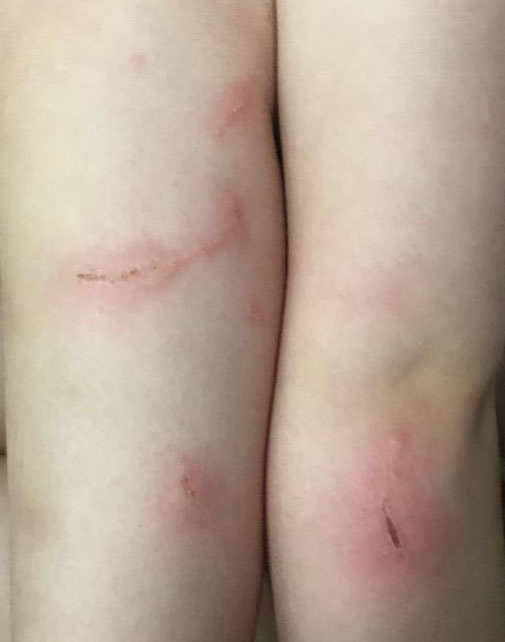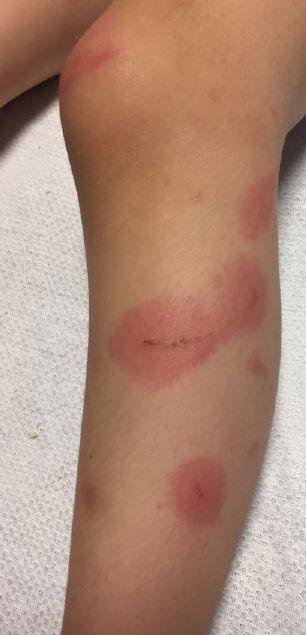By: Sarah Asch, MS, MD, FAAP, FAAD & Matthew Mahoney, DO
When skin touches poison ivy, poison oak, or poison sumac plants, the oils from the plant can cause a rash. This rash can be very uncomfortable, itchy, and unsightly. The medical name for this rash is
contact dermatitis. Since the rash caused by all of these plants is the same, we will call it all "poison ivy," but the same rules apply no matter which plant is involved!
What are the symptoms of a skin reaction to poison ivy, oak or sumac?
 About half of children who come in contact with these plants have an allergic reaction to the oils in the plant. It takes a few hours to a few days for the rash to start. The skin that has touched the plant develops itchy, red, and swollen streaks or patches.
About half of children who come in contact with these plants have an allergic reaction to the oils in the plant. It takes a few hours to a few days for the rash to start. The skin that has touched the plant develops itchy, red, and swollen streaks or patches.
Later, blisters can form. Sometimes the blisters break open and clear fluid comes out of them. It is common for the blisters to show up in different areas of the rash at different times. Sometimes the rash will show up in areas that did not touch the plants, like the genitals. This happens when the plant's oil is spread from one part of the body to another before washing the skin.
Are skin reactions to poison ivy contagious?
Skin reactions to poison ivy are not contagious and cannot be passed from one person to another. However, the oil can be spread from one person's skin or on clothing or other objects until the skin and any other contaminated items are thoroughly washed. Multiple children can get the rash if they come in contact with the same plant or the oil from the plant. Touching the blisters or fluid inside them does not spread the rash.
How are skin reactions to poison ivy diagnosed?
Most reactions to poison ivy are diagnosed by looking at the rash. No further tests are available.
What if your child comes in contact with poison ivy?
 If your child touches a poison ivy plant or touches something that has the plant's oil on it, their skin should be washed immediately. The skin can be washed with soap or dishwashing detergent. It should be rinsed with cool water to remove the soap or detergent to avoid irritation. Wash the skin gently and do not scrub. Scrubbing the skin can spread the plant's oil. Be sure to wash under the nails, as oil can get trapped there.
If your child touches a poison ivy plant or touches something that has the plant's oil on it, their skin should be washed immediately. The skin can be washed with soap or dishwashing detergent. It should be rinsed with cool water to remove the soap or detergent to avoid irritation. Wash the skin gently and do not scrub. Scrubbing the skin can spread the plant's oil. Be sure to wash under the nails, as oil can get trapped there.
You should also wash anything that came in contact with the plant including clothing, footwear, toys, outdoor gear, or gardening tools. It is important to wash your pet's fur if they came in contact with the plant too.
How are skin reactions to poison ivy treated?
Skin reactions to poison ivy typically heal in about two weeks. While most cases can be treated at home, severe cases such as those involving the face or genitals should be seen by your child's pediatrician. The pediatrician may prescribe steroids that can be applied to the skin (topical) or, if it is very severe, taken by mouth (oral). Usually the rash gets better in 2-3 weeks, but it can be extremely itchy until it is gone.
To help with itching, we recommend the following home treatments:
Treating the itch is important because more scratching can make the itching worse and scratching the skin can lead to an infection
You may apply calamine lotion 3-4 times per day to the rash
You may apply hydrocortisone 1% cream twice per day to the rash
Use cool, wet compresses on the rash. You can put these on top of the calamine lotion or hydrocortisone cream.
For more widespread itch, a cool or lukewarm shower or bath can feel soothing
More information
About Dr. Asch
 Sarah Asch, MD, FAAP, FAAD, is a solo pediatric dermatologist at Hometown Pediatric Dermatology. She is active in pediatric teledermatology and is passionate about expanding subspecialty pediatric dermatology care for rural areas. She is a member of the American Academy of Pediatrics (Sections on Dermatology and Telehealth), a member of the Society for Pediatric Dermatology; and is a Medical Director at the American Academy of Dermatology's Camp Discovery. Sarah Asch, MD, FAAP, FAAD, is a solo pediatric dermatologist at Hometown Pediatric Dermatology. She is active in pediatric teledermatology and is passionate about expanding subspecialty pediatric dermatology care for rural areas. She is a member of the American Academy of Pediatrics (Sections on Dermatology and Telehealth), a member of the Society for Pediatric Dermatology; and is a Medical Director at the American Academy of Dermatology's Camp Discovery.
|
About Dr. Mahoney
 Matthew Mahoney, DO, is currently a pediatric resident physician at the University of Minnesota and M Health Fairview Masonic Children's Hospital. After completing training in pediatrics, he will continue with residency in dermatology, also at the University of Minnesota. His clinical interests include pediatric dermatology, patient and family education, and improving the ways physicians share unexpected news. He is a member of the American Academy of Pediatrics Section on Dermatology Education Committee. Matthew Mahoney, DO, is currently a pediatric resident physician at the University of Minnesota and M Health Fairview Masonic Children's Hospital. After completing training in pediatrics, he will continue with residency in dermatology, also at the University of Minnesota. His clinical interests include pediatric dermatology, patient and family education, and improving the ways physicians share unexpected news. He is a member of the American Academy of Pediatrics Section on Dermatology Education Committee.
Poison ivy rash images courtesy Sarah Stein, MD, FAAD, FAAP
|